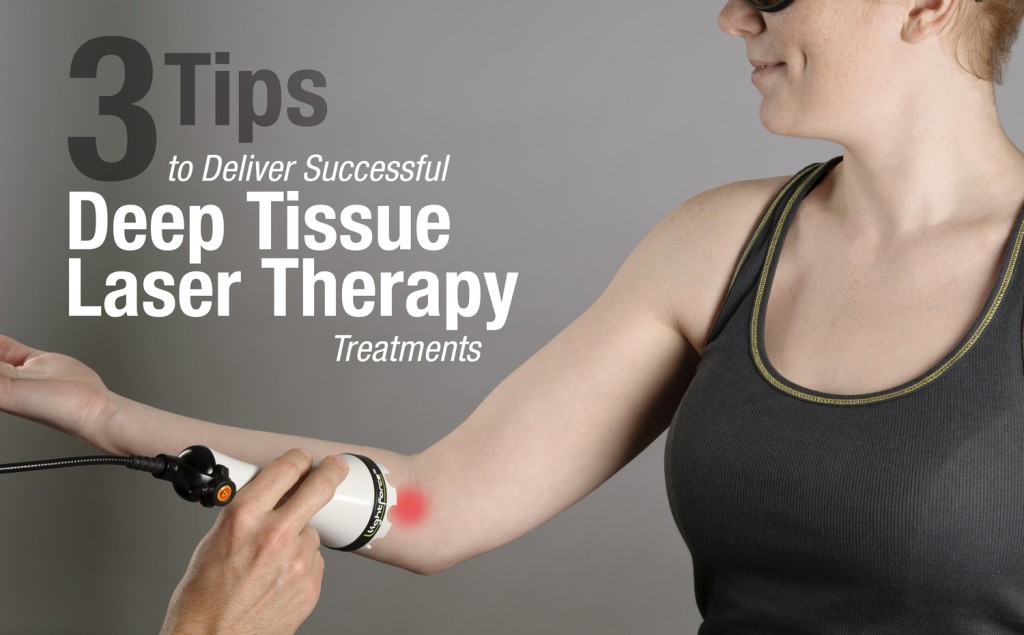3 Tips to Deliver Successful Deep Tissue Laser Therapy Treatments

Laser therapy is a powerful tool that can deliver incredible results. As with any modality, the best outcomes are achieved when treatment is applied in the correct circumstances and administered with appropriate technique. Below are 3 tips to help you deliver the right dose, for every condition and every patient, every time.
1. Evaluate the Situation
Before beginning laser therapy, take time to look at relevant condition-related variables and consider whether you want to integrate laser therapy as part of the treatment course.
One variable you need to consider is how receptive the condition will be to laser therapy. Conditions that exhibit inflammation are likely to respond well, so most “itis” conditions are good candidates. You should also look at using laser therapy in circumstances where pain reduction is a primary objective. Since most inflammatory conditions such as arthritis, epicondylitis, and plantar fasciitis are painful, laser therapy can often be used to accomplish both pain and inflammation reduction simultaneously. Acuteness of the condition should also be looked at. If a condition is chronic, treatments should be modified to maximize outcomes. A good rule of thumb when addressing chronic conditions is to start treating with reduced power and slowly increase the power as treatments continue, depending on patient progress and feedback.
2. Educate the Patient
Setting expectations is an important part of any treatment plan and will help increase overall satisfaction. Patients generally want to know not only what laser therapy is, but also what treatments are like, how many treatments will possibly be needed, and what level of results they should expect.
Make it a priority to educate patients about laser therapy, both before and during treatment. Patients should be able to start learning about laser therapy before they even schedule an appointment. Having a page on your website dedicated to laser therapy, with videos, FAQs, and testimonials shows patients you are committed to providing them with the best treatment options and are confident in the therapy.
Laser therapy education should continue once patients are in the office, so you will want to equip your staff and space with relevant information. Some patients will want to know details about how it works, while others will only want to know whether it works – so make sure the staff is enabled to provide answers, either directly or through external resources like blogs and videos. You should also put up posters and banners, and have brochures at the front desk for patients to read while they are waiting for their appointment – enable your patients to educate themselves.
Once patients know what laser therapy is and what it can be used to treat, they then want to know what treatments are like. When consulting with patients who have opted to begin laser therapy treatments, let the patient know that they can expect to feel a gentle warmth as the laser is being applied. You can also tell them approximately how long the treatments last, which is dependent on the condition but typically within the range of 5-10 minutes.
Finally, it is critical to set expectations related to results. Patients with acute conditions will often respond better and quicker than patients with chronic conditions, so certain chronic conditions may require more treatments and may not resolve as fully as acute conditions. As long as this expectation is set clearly and early, patients are usually very happy with their results.
3. Take Time to Treat Properly
It doesn’t matter how well a treatment plan is developed if it isn’t executed well. As with many modalities, laser therapy works best when certain treatment technique guidelines are followed and proper dosages are delivered.
One important technique consideration is the application of laser therapy directly to the skin’s surface – not through clothing or bandages. Fabric both absorbs and reflects a great deal of light, reducing the amount of energy able to reach the target and therefore inhibiting delivery of a full dose (see a video demonstration here). To further increase the amount of light reaching the target, the handpiece should also be held perpendicularly to the skin’s surface, to help minimize scattering and reflection of light off the skin.
Optimal outcomes are achieved by fully saturating the area being treated with laser light. The handpiece should be moved in a painting motion and applied in a grid-like pattern, so that the desired area is completely and evenly covered. If treating an extremity, it is also advisable to move the handpiece around the limb 360 degrees to reach all available angles. Laser therapy dosing is measured in joules/cm2, so coverage area is an important factor.
Treatments should also be delivered on contact, unless there is a clear reason to not do so. During on-contact treatment, less light is scattered, and the pressure from the massage ball attachment helps to displace superficial fluids, allowing more energy to reach the target and enabling more accurate dosing. Using active range of motion further encourages proper dose delivery to deep target structures.
By following these 3 tips, you can ensure your patients are getting the most out of their laser therapy treatments, each and every time!

Comments